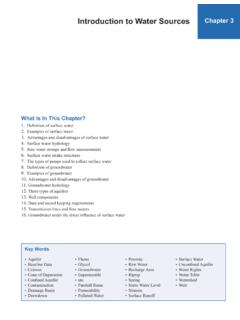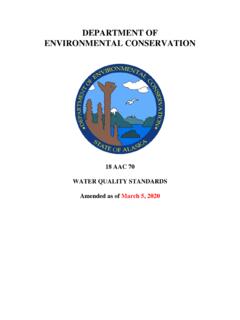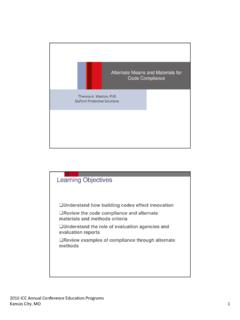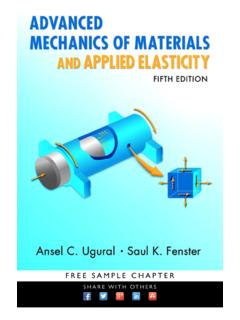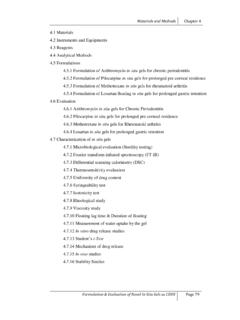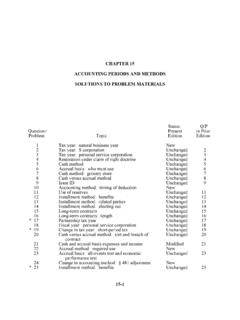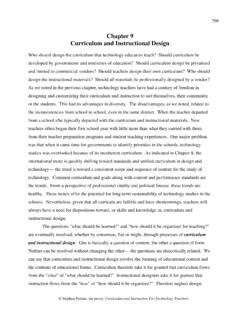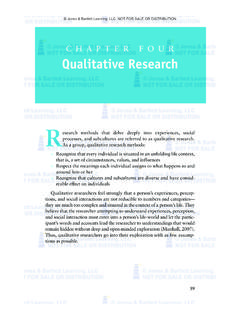Transcription of Introduction to Water Distribution Systems Chapter 5
1 Chapter 5 What Is In This Chapter ?1. Functions of a Distribution system2. Types of Distribution systems3. Common Distribution piping materials4. Common Distribution system fittings5. Major components of piped systems6. Distribution system pipe installation7. Common household service equipment and materials8. Common reservoirs and their components9. Typical utilidor components and operation10. Basic operation and maintenance requirements of a Distribution system11. Common methods to control cross connectionsIntroduction to Water Distribution SystemsKey Words C Factor Air Gap Altitude Valve Appurtenances AWWA Backflow Backsiphonage Butterfly Valve Compression Hydrant Cross Connection Double Check HDPE Hydrant Bury Invert Mechanical Joint MVO NSF Peak Demand PVC Reservoir RPZ Seal Water Slide Gate Hydrant Thrust Block Toggle Hydrant Vacuum Breaker Water Hammer148 Chapter 5 Introduction to Water Distribution SystemsLesson ContentThis lesson on the Introduction to Distribution Systems is focused on the description of the various components of a Distribution system , their function, and their purpose.
2 Some details on the proper operation and maintenance of components in a distribu-tion system are covered here, but you may want to consult additional manuals for a more detailed FactorsIn most communities, the Water Distribution system is their largest single capital investment. To preserve this investment, careful attention should be paid to the proper operation and maintenance of the system . This starts with a good understanding of the components and their Function and DesignThe basic function of a Water Distribution system is to transport the Water from the treatment facility to the customer. In addition, Distribution Systems may also provide storage, as well as provide flow and pressure adequate for fire protection. Typically, the size of Water mains, pump station capacity, and storage reservoir volume is deter-mined by fire suppression needs. The volume of Water necessary to fight fires is much greater than domestic and commercial Water demand in most CriteriaTo provide this basic function in a proper manner, criteria have been established for Distribution Systems .
3 Distribution Systems should provide adequate and reliable Water to the customer. Adequate means providing all the Water the customer needs at a pressure not less than 20 psi. Adequate also means that the Water provided meets the customer s needs for quality. Reliable means that customers can expect to obtain all the Water they need, anytime they need it. In other words, they can expect that there will be Water at the tap. As part of being adequate and reliable, the system must be operated in a way so that the quality of the Water does not deteriorate between the treatment facility and the customer. In many communities, the customer expects that adequate reserves are present for fire prevention. If there are fire hydrants on the system , the customer has every right to make this assumption, and the purveyor has the responsibility for meeting this expec-tation by providing adequate flow, pressure, and storage of SystemsIn many villages in Alaska and Canada, watering points substitute for a normal Distribution system .
4 These are Systems with one or more specific points in the village where the customer can obtain Water . This is the modern version of the community well. In some villages, there is a combination circulating system and watering points. The watering points are used by those customers who have homes away from the piped type of system found in Alaska and Canada is the haul system . With the haul system , Water is delivered using a truck and tank or a snow machine and tank. The Water is delivered on order in much the same manner as fuel oil is 5 Introduction to Water Distribution SystemsThe most traditional Water Distribution system is the piped system . There are two types of piped Systems : the conventional system and the completely looped circulat-ing system . The circulating system is common in the arctic. Review1. List the three primary functions of a Water Distribution system . 2. What are the two criteria for a Water Distribution system ?3.
5 The pressure in a Water Distribution system should never drop below _____ watering point is a location in a village where customers can access the Water supply. In some villages, the only source of Water for customers is from the watering point. There may be more than one watering point in the village, depending on its treatment process for a watering point system is the same as for a piped storage reservoir may or may not be necessary for a watering point system , de-pending on source production. The reservoir may be close to or inside the treatment plant. Standard reservoir designs are used in these Systems . The reservoirs may be steel, concrete, or wooden gravity tanks or steel hydropneumatic the watering point is near or adjacent to the treatment plant, the piping material used is the same as would be used in the treatment plant; copper, galvanized steel, PVC1, and HDPE2 are common. When the watering point is away from the treatment plant, the piping material is the standard material used in piped Distribution Systems for that particular are as many methods of obtaining Water from the watering point as there are watering points.
6 The most common of these techniques is to use a flexible hose and automatic hose reel. The hose must consist of NSF3-approved material , not a garden hose. In cold climates, reinforced, arctic-grade, heat-traced hose with a PVC liner may be provided. A means of backflow4 prevention must be provided to protect the public system from potential some instances, the watering point may contain a coin, key, or coupon-operated dispensing system and a meter. Each coupon will allow a set volume of Water to be delivered. The coupon system allows the village to obtain a fair payment for the cost of treating the Water , as well as operating and maintaining the watering Point System3 NSF National Sanitation PVC Polyvinyl Chloride. A plastic pipe made by forcing heated plastic through a HDPE High-density Backflow A reverse flow condition, created by a difference in Water pres-sures, which causes nonpotable Water to flow into a potable Water 5 Introduction to Water Distribution SystemsPiped Distribution SystemDescriptionA haul delivery system may be supplemented or used in conjunction with a standard piped system , such as in Fairbanks and Barrow, or may be the only means of Water being delivered to the treatment process for a haul system is the same as for a piped system or watering most common haul Systems use a high-quality tank mounted on a truck or snow machine.
7 The Water in the tank is prevented from freezing by using the heat from the engine exhaust methods used to get Water from the truck to the customers holding tank is typi-cally 1 -inch or larger NSF-approved flexible pipe. In cold climates, a reinforced arctic-grade, heat-traced hose with a PVC liner may be used. Sometimes a dispens-ing pipe is elevated so that haul trucks can park beneath the Water pipe. A means of backflow prevention must be provided to protect the public system from potential delivery tank should be cleaned and disinfected with a chlorine solution similar to the disinfection process used for a reservoir. Hauling tanks should not be used for other purposes such as pesticide or sewage piped system can vary from simple to extremely complicated. Most piped Systems have the same basic components: pipes, valves, fire hydrants, service connections, and reservoirs. Piped Systems may also have pumping stations. The following de-scribes the various components that can be found in a piped system , excluding Line Piping MaterialsGray Cast Iron Pipe (GCIP) Gray cast iron pipe used in the waterworks industry is manufactured to meet AWWA5 standard C-106.
8 This is some of the oldest piping material in use today. Over 200 cities in the United States have pipe installed that has been in use for over 100 years. Gray cast iron pipe was first manufactured using a process called pit casting. In this process, the molten iron was poured into a mold and allowed to cool. In 1925, a pro-cess called spin casting was developed. In this process, molten iron is injected into a spinning mold. The result is a pipe of consistent diameter and wall Cast Iron Pipe (DCIP)Ductile cast iron is not an alloy. It is formed by injecting magnesium into molten cast iron. The treatment changes the carbon structure of cast iron from a flake to a spheri-Haul System5 AWWA (American Water Works Association) An association of wa-terworks personnel, equipment manu-facturers, suppliers, and 5 Introduction to Water Distribution Systemscal shape. This alteration results in a material of high strength. It can withstand high impacts, both internally and externally; it has great beam strength (won t break eas-ily); and it is much better in resisting corrosion than gray cast cast iron pipe is commonly manufactured using the spin cast system .
9 In this process, molten cast iron is injected into either a metal or sand-lined spinning mold. DCIP pipe is available in sizes ranging from three inches to 54 inches and comes in 18-foot and 20-foot lengths. Lining it with a thin coating of cement mortar enhances the hydraulic capabilities and corrosion resistance of the pipe. Under these condi-tions, the Hazen and Williams C Factor6 for the pipe is cast iron pipe is commonly connected using mechanical joints7 ( ), flanges or the various common rubber ring push-on joints. Fittings used are com-monly made of gray or ductile cast iron and use or hub joints. Push-on joints are typically used for buried pipe installed below grade because they are quickly as-sembled and the least expensive. Service taps are made by directly tapping the line or using service jointRubber ring push-on jointAsbestos Cement ( ) pipe is also referred to as TransiteTM, which is the trademark of the Johns-Manville Corporation, one of the first manufacturers of the material .
10 The pipe is made by spraying a solution of portland cement, long fibrous asbestos, silica sand, and Water onto a spinning anvil. The pipe is then shaped and placed in an autoclave to ENDROUGH pipe6 C Factor The factor used in the Hazen and Williams equation for determining headloss. The C Factor is a representation of the hydraulic roughness of the pipe. The larger the number, the smoother the pipe is Mechanical Joint A joint used on cast iron valves, fittings, fire hydrants, and cast iron pipe. The joint consists of a rubber gasket and follower ring held to a flange by a row of bolts. The gasket is compressed between the fol-lower ring and the flange 5 Introduction to Water Distribution pipe is available in sizes from three inches to 36 inches and comes in a standard length of 13 feet. There are two common dimensions associated with pipe. The outside dimension of the pipe itself is referred to as the rough barrel. The outside dimension where the coupling fits is referred to as the machined end.
